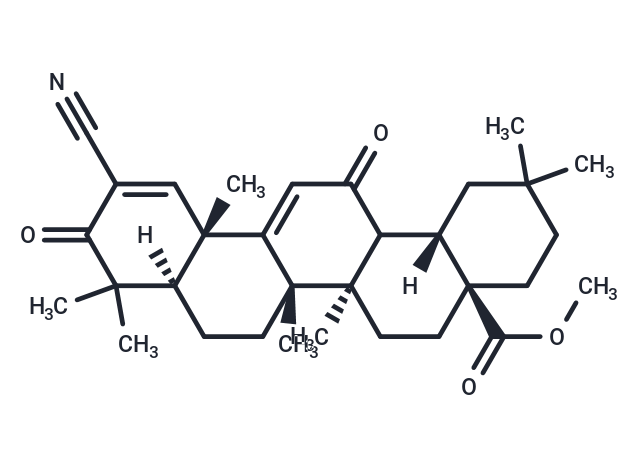Shopping Cart
Remove All Your shopping cart is currently empty
Your shopping cart is currently empty
Bardoxolone Methyl (TP-155) is a synthetic triterpenoid that acts as an activator of the Nrf2 pathway and an inhibitor of the NF-κB pathway with potential anti-tumor and anti-inflammatory activities.

| Pack Size | Price | USA Warehouse | Global Warehouse | Quantity |
|---|---|---|---|---|
| 10 mg | $39 | In Stock | In Stock | |
| 25 mg | $59 | In Stock | In Stock | |
| 50 mg | $80 | In Stock | In Stock | |
| 100 mg | $122 | In Stock | In Stock | |
| 500 mg | $333 | In Stock | In Stock | |
| 1 mL x 10 mM (in DMSO) | $43 | In Stock | In Stock |
| Description | Bardoxolone Methyl (TP-155) is a synthetic triterpenoid that acts as an activator of the Nrf2 pathway and an inhibitor of the NF-κB pathway with potential anti-tumor and anti-inflammatory activities. |
| In vitro | Bardoxolone Methyl exhibits potent inhibitory activities against production of nitric oxide induced by interferon-? in mouse macrophages with IC50 of 0.1 nM. [1] Bardoxolone Methyl decreases the viability of leukemic HL-60, KG-1, and NB4 cells with IC50 of 0.4, 0.4, and 0.27 μM, respectively. CDDO-Me induces pro-apoptotic Bax protein, inhibits the activation of ERK1/2, and it blocks Bcl-2 phosphorylation, which contributes to the induction of apoptosis. [2] Bardoxolone Methyl potently inhibits both constitutive and inducible NF-kappaB activated by TNF, interleukin (IL)-1beta, phorbol ester, okadaic acid, hydrogen peroxide, lipopolysaccharide, and cigarette smoke. [3] |
| In vivo | Bardoxolone Methyl (60 mg/kg) reduces the number, size, and severity of lung tumors in vivo. [4] Bardoxolone Methyl significantly reduces the in vivo inflammatory cytokine response following LPS challenge, induces HO-1 protein expression in the spleen, and protects mice against lethal-dose LPS. [5] |
| Kinase Assay | IKK assay : To determine the effect of CDDO-Me on TNF-induced IKK activation, IKK is analyzed. Briefly, the IKK complex from whole-cell extracts was precipitated with antibody against IKKα and IKKβ and then treated with protein A/G-Sepharose beads. After 2 hours, the beads are washed with lysis buffer and then resuspended in a kinase assay mixture containing 50 mmol/L HEPES (pH 7.4), 20 mmol/L MgCl2, 2 mmol/L DTT, 20 μCi [γ-32P]ATP, 10 μmol/L unlabeled ATP, and 2 μg of substrate glutathione S-transferase-IκBα (amino acids 1-54). After incubation at 30°C for 30 minutes, the reaction is terminated by boiling with SDS sample buffer for 5 minutes. Finally, the protein is resolved on 10% SDS-PAGE, the gel is dried, and the radioactive bands are visualized with a Storm820. To determine the total amounts of IKK-α and IKK-β in each sample, 50 μg of whole-cell proteins are resolved on 7.5% SDS-PAGE, electrotransferred to a nitrocellulose membrane, and then blotted with either anti-IKK-α or anti-IKK-β antibody. |
| Cell Research | Leukemic cell lines are cultured at a density of 3.0 × 105 cells/mL, and AML mononuclear cells are cultured at 5 × 105 cells/mL in the presence or absence of indicated concentrations of CDDO-Me. Appropriate amounts of DMSO (final concentration less than 0.05%) are included as control. For cytotoxicity studies, 1 μM ara-C is added to the cultures. After 24 to 72 hours, viable cells are counted with the trypan blue dye exclusion method using a hematocytometer. (Only for Reference) |
| Synonyms | TP-155, RTA 402, NSC 713200, CDDO Methyl ester |
| Molecular Weight | 505.69 |
| Formula | C32H43NO4 |
| Cas No. | 218600-53-4 |
| Smiles | [H][C@@]12CC(C)(C)CC[C@@]1(CC[C@]1(C)C2C(=O)C=C2[C@@]1(C)CC[C@@]1([H])C(C)(C)C(=O)C(=C[C@]21C)C#N)C(=O)OC |
| Relative Density. | 1.15g/cm3 |
| Storage | Powder: -20°C for 3 years | In solvent: -80°C for 1 year | Shipping with blue ice/Shipping at ambient temperature. | ||||||||||||||||||||||||||||||
| Solubility Information | H2O: < 1 mg/mL (insoluble or slightly soluble) DMSO: 40.83 mg/mL (80.74 mM), Sonication is recommended. Ethanol: < 1 mg/mL (insoluble or slightly soluble) | ||||||||||||||||||||||||||||||
| In Vivo Formulation | 10% DMSO+40% PEG300+5% Tween 80+45% Saline: 2 mg/mL (3.95 mM), Sonication is recommended. Please add the solvents sequentially, clarifying the solution as much as possible before adding the next one. Dissolve by heating and/or sonication if necessary. Working solution is recommended to be prepared and used immediately. The formulation provided above is for reference purposes only. In vivo formulations may vary and should be modified based on specific experimental conditions. | ||||||||||||||||||||||||||||||
Solution Preparation Table | |||||||||||||||||||||||||||||||
DMSO
| |||||||||||||||||||||||||||||||
| Size | Quantity | Unit Price | Amount | Operation |
|---|

Copyright © 2015-2025 TargetMol Chemicals Inc. All Rights Reserved.